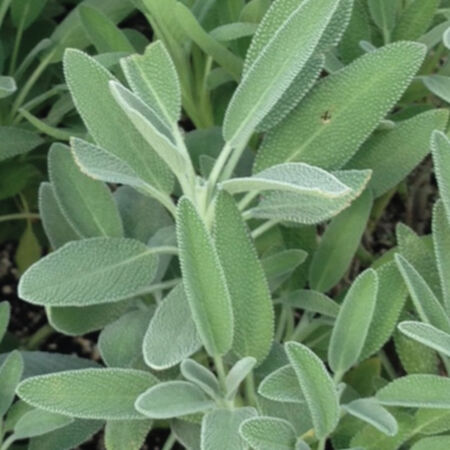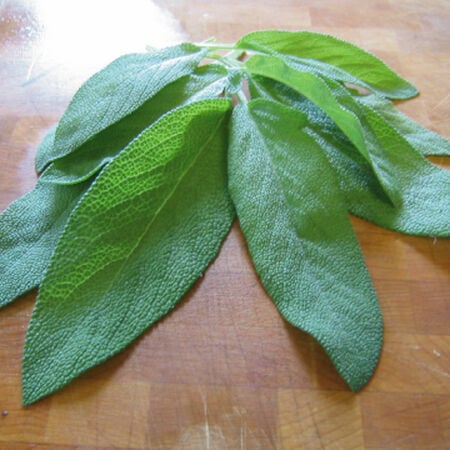Broadleaf, Sage Seed
Key Attributes
Product Details
Weight
0.008Depth
0.1Height
4.5Width
3.25Plant Height
1-3'Botanical Name
Salvia apianaSeed Type
SeedSeeds Per Gram
109Seeds Per Pound
49,600Packet
50 SeedsSow Depth
1/4"Seeds Per Ounce
3,100Breed
Open-pollinatedSun
Full SunGrowing Conditions
Container FriendlyLife Cycle
PerennialSow Method
TransplantDirect SowCategories
HerbGermination
11,12,13,14,15,16,17,18,19,7,8,9,20,10,21Days To Maturity (# Days)
80Components
Growing Instructions
![]() Learning Download: How to Grow Sage
Learning Download: How to Grow Sage
Sage is a shrub-like herb that grows dusty, soft, green leaves. Sage is usually used in dressings, stuffing or to season meats. It also has medicinal properties that allow it to aid in digestion and healing colds. It is a hardy perennial, which means it will come back year after year. However, in warmer climates, sage is usually grown as an annual because it doesn’t grow well in humidity.
Before Planting:
Planting: Plant the seeds or cuttings indoors up to 10 weeks before the last frost. Plant outdoors up to two weeks before the last frost and leave 30 inches between the seeds or cuttings when planting. Sage does well when planted near cabbage, carrots and rosemary, but do not plant sage near cucumbers.
Watering: When sage plants are young, water them frequently to prevent them from drying out.
Fertilizer: Twice during its growing season, side dress the plant with compost or a compost tea, especially if the plant is grown in a container. This replaces the nutrients in the soil. Sage doesn’t require any other fertilizer.
Days to Maturity: Once the leaves are full size, they are able to be pulled off. (See variety for days to maturity)
Harvesting: To harvest individual leaves, pull them off by hand. Entire stems also can be cut, and they should be snipped at their base. Sage can be harvested in its first year but harvest lightly so the plant grows back completely
the following year. During its first year, do not harvest all the leaves from the plant at once. Once sage is established, it can be harvested all year long. Although sage is best fresh, it can be dried by leaving harvested leaves out in the sun and then removing the leaves from the branches and storing them in an airtight container.
Tips: Each spring, prune back the woody stems. For the best quality of sage, replace the plants every five years as it begins to become woodier the older the plant gets.
Shipping Schedule
Our Seed Promise
 "Agriculture and seeds" provide the basis upon which our lives depend. We must protect this foundation as a safe and genetically stable source for future generations. For the benefit of all farmers, gardeners and consumers who want an alternative, we pledge that we do not knowingly buy or sell genetically engineered seeds or plants.
"Agriculture and seeds" provide the basis upon which our lives depend. We must protect this foundation as a safe and genetically stable source for future generations. For the benefit of all farmers, gardeners and consumers who want an alternative, we pledge that we do not knowingly buy or sell genetically engineered seeds or plants.
The mechanical transfer of genetic material outside of natural reproductive methods and between genera, families or kingdoms, poses great biological risks as well as economic, political, and cultural threats. We feel that genetically engineered varieties have been insufficiently tested prior to public release. More research and testing is necessary to further assess the potential risks of genetically engineered seeds. Further, we wish to support agricultural progress that leads to healthier soils, to genetically diverse agricultural ecosystems, and ultimately to healthy people and communities.
To learn more about the "Safe Seed Pledge" please visit www.councilforresponsiblegenetics.org.
Key Attributes
Product Details
Weight
0.008Depth
0.1Height
4.5Width
3.25Plant Height
1-3'Botanical Name
Salvia apianaSeed Type
SeedSeeds Per Gram
109Seeds Per Pound
49,600Packet
50 SeedsSow Depth
1/4"Seeds Per Ounce
3,100Breed
Open-pollinatedSun
Full SunGrowing Conditions
Container FriendlyLife Cycle
PerennialSow Method
TransplantDirect SowCategories
HerbGermination
11,12,13,14,15,16,17,18,19,7,8,9,20,10,21Days To Maturity (# Days)
80Components
Growing Instructions
![]() Learning Download: How to Grow Sage
Learning Download: How to Grow Sage
Sage is a shrub-like herb that grows dusty, soft, green leaves. Sage is usually used in dressings, stuffing or to season meats. It also has medicinal properties that allow it to aid in digestion and healing colds. It is a hardy perennial, which means it will come back year after year. However, in warmer climates, sage is usually grown as an annual because it doesn’t grow well in humidity.
Before Planting:
Planting: Plant the seeds or cuttings indoors up to 10 weeks before the last frost. Plant outdoors up to two weeks before the last frost and leave 30 inches between the seeds or cuttings when planting. Sage does well when planted near cabbage, carrots and rosemary, but do not plant sage near cucumbers.
Watering: When sage plants are young, water them frequently to prevent them from drying out.
Fertilizer: Twice during its growing season, side dress the plant with compost or a compost tea, especially if the plant is grown in a container. This replaces the nutrients in the soil. Sage doesn’t require any other fertilizer.
Days to Maturity: Once the leaves are full size, they are able to be pulled off. (See variety for days to maturity)
Harvesting: To harvest individual leaves, pull them off by hand. Entire stems also can be cut, and they should be snipped at their base. Sage can be harvested in its first year but harvest lightly so the plant grows back completely
the following year. During its first year, do not harvest all the leaves from the plant at once. Once sage is established, it can be harvested all year long. Although sage is best fresh, it can be dried by leaving harvested leaves out in the sun and then removing the leaves from the branches and storing them in an airtight container.
Tips: Each spring, prune back the woody stems. For the best quality of sage, replace the plants every five years as it begins to become woodier the older the plant gets.
Shipping Schedule
Our Seed Promise
 "Agriculture and seeds" provide the basis upon which our lives depend. We must protect this foundation as a safe and genetically stable source for future generations. For the benefit of all farmers, gardeners and consumers who want an alternative, we pledge that we do not knowingly buy or sell genetically engineered seeds or plants.
"Agriculture and seeds" provide the basis upon which our lives depend. We must protect this foundation as a safe and genetically stable source for future generations. For the benefit of all farmers, gardeners and consumers who want an alternative, we pledge that we do not knowingly buy or sell genetically engineered seeds or plants.
The mechanical transfer of genetic material outside of natural reproductive methods and between genera, families or kingdoms, poses great biological risks as well as economic, political, and cultural threats. We feel that genetically engineered varieties have been insufficiently tested prior to public release. More research and testing is necessary to further assess the potential risks of genetically engineered seeds. Further, we wish to support agricultural progress that leads to healthier soils, to genetically diverse agricultural ecosystems, and ultimately to healthy people and communities.
To learn more about the "Safe Seed Pledge" please visit www.councilforresponsiblegenetics.org.




